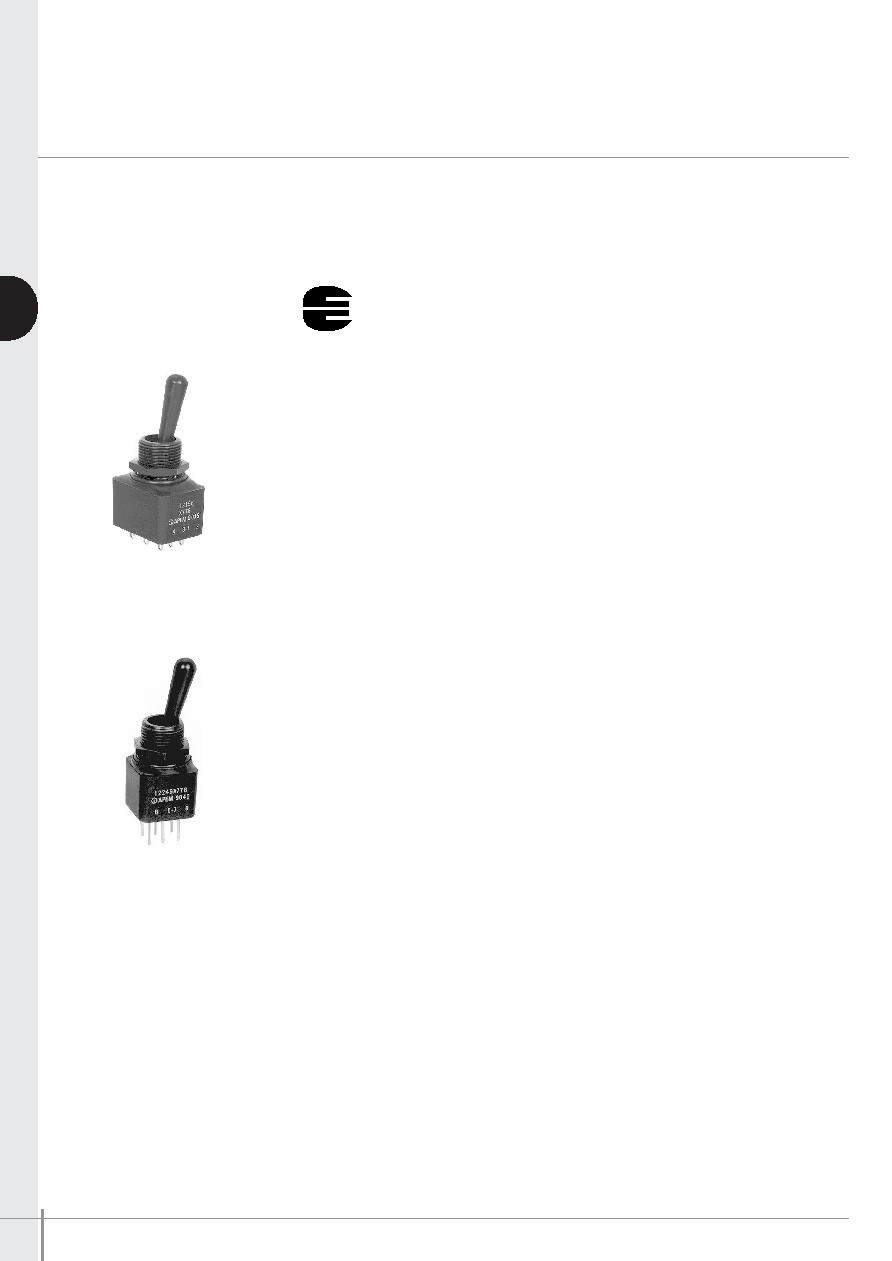- 您現(xiàn)在的位置:買賣IC網(wǎng) > PDF目錄282654 > 7301MPYW1GI2 TOGGLE SWITCH, DP3T, MOMENTARY, 4A, 28VDC, PANEL MOUNT-THREADED PDF資料下載
參數(shù)資料
| 型號: | 7301MPYW1GI2 |
| 元件分類: | 開關(guān) |
| 英文描述: | TOGGLE SWITCH, DP3T, MOMENTARY, 4A, 28VDC, PANEL MOUNT-THREADED |
| 文件頁數(shù): | 1/7頁 |
| 文件大小: | 525K |
| 代理商: | 7301MPYW1GI2 |

A-78
APEM
www.apem.com
12000X778 series
High performance toggle switches - threaded bushing 11,9 (15/32)
Distinctive features
A
K
Approval and lists
CECC 96201-005
CECC 96201-008
MUAHAG and QPL listed (Europe only)
French defence approved : DAT list No A5999 X001.
This range of professional toggle switches is suitable for use in military and
other high specification environments.
K
Contacts
Highly reliable contacts suitable for low level applications (10mA 50mV -
10A 5VDC min.) or power applications (2A 250VAC - 4A 125VAC -
4A 30VDC max.)
K
Pinned lever
The base of the switch lever is pinned to the bushing, thus earthing the lever to
the bushing. This also provides strain relief to protect the switch if accidentally
knocked.
K
Double shell case
For high mechanical strength and high electrical insulation.
K
Compact size
The small rear end of the switch allows space saving behind the panel.
K
Finish
Matt black finish on body, bushing, lever and hardware.
K
Sealing
Panel sealed to IP 67, these switches are frontal sealed by two O-rings and
have full rear end sealing.
K
Accessories
A comprehensive range of protection boots (both full and half length), locking
levers and security caps are available.
相關(guān)PDF資料 |
PDF描述 |
|---|---|
| 7301MPYW4PI2 | TOGGLE SWITCH, DP3T, MOMENTARY, 4A, 28VDC, PANEL MOUNT-THREADED |
| 7301MPYW5GI22 | TOGGLE SWITCH, DP3T, MOMENTARY, 4A, 28VDC, PANEL MOUNT-THREADED |
| 7301L42Y9AW4GE32 | TOGGLE SWITCH, DP3T, MOMENTARY, 4A, 28VDC, PANEL MOUNT-THREADED |
| 7301L42Y9V21PE22 | TOGGLE SWITCH, DP3T, MOMENTARY, 4A, 28VDC, PANEL MOUNT-THREADED |
| 7301MPH3APE32 | TOGGLE SWITCH, DP3T, MOMENTARY, 4A, 28VDC, PANEL MOUNT-THREADED |
相關(guān)代理商/技術(shù)參數(shù) |
參數(shù)描述 |
|---|---|
| 7301MPYZBE | 功能描述:撥動開關(guān) RoHS:否 制造商:C&K Components 觸點形式:DPDT 開關(guān)功能:ON - ON - ON 電流額定值: 電壓額定值 AC:20 V 電壓額定值 DC:20 V 功率額定值:0.4 VA 端接類型:V-Bracket 安裝風(fēng)格: 端子密封:Epoxy 觸點電鍍:Gold 照明:Not Illuminated |
| 7301MPYZQE | 功能描述:撥動開關(guān) RoHS:否 制造商:C&K Components 觸點形式:DPDT 開關(guān)功能:ON - ON - ON 電流額定值: 電壓額定值 AC:20 V 電壓額定值 DC:20 V 功率額定值:0.4 VA 端接類型:V-Bracket 安裝風(fēng)格: 端子密封:Epoxy 觸點電鍍:Gold 照明:Not Illuminated |
| 7301MY9CQE | 功能描述:撥動開關(guān) RoHS:否 制造商:C&K Components 觸點形式:DPDT 開關(guān)功能:ON - ON - ON 電流額定值: 電壓額定值 AC:20 V 電壓額定值 DC:20 V 功率額定值:0.4 VA 端接類型:V-Bracket 安裝風(fēng)格: 端子密封:Epoxy 觸點電鍍:Gold 照明:Not Illuminated |
| 7301MYAQE | 制造商:C&K Components 功能描述:SWIT TGL ON NONE ON 3PDT TGL PC PINS 5A 250VAC 28VDC PNL MNT - Bulk 制造商:C&K Components 功能描述:Switch Toggle ON None ON 3PDT Round Toggle PC Pins 5A 250VAC 28VDC PC Mount with Bracket and Threads |
| 7301MYAV2KE | 功能描述:撥動開關(guān) Toggle RoHS:否 制造商:C&K Components 觸點形式:DPDT 開關(guān)功能:ON - ON - ON 電流額定值: 電壓額定值 AC:20 V 電壓額定值 DC:20 V 功率額定值:0.4 VA 端接類型:V-Bracket 安裝風(fēng)格: 端子密封:Epoxy 觸點電鍍:Gold 照明:Not Illuminated |
發(fā)布緊急采購,3分鐘左右您將得到回復(fù)。